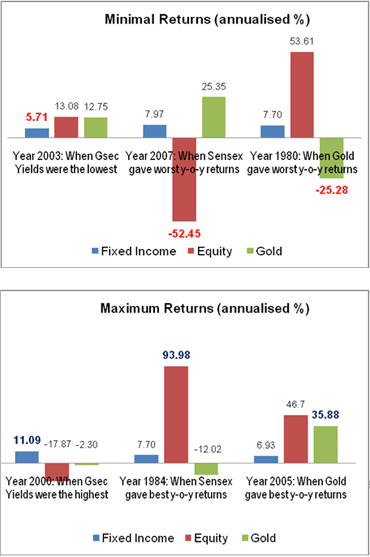Dhanashri Rane, Fundsupermart.co.in
As economic conditions remain fragile, the equity markets around the globe have corrected drastically in last few days on account of poor investor sentiment. In this article, we aim to analyse what works and what doesn't in good and bad times!
Basic rule of diversification: Don't put all your eggs in the same basket. By choosing to invest in multiple assets, we cut down on the volatility experienced by one asset with another. At times, one may come across an investment proposition that seems like a 'good bet', but its potential volatility may skew the risk profile of your portfolio.
In such situations, a core and supplementary portfolio structure allows you to manage risks better.
Click NEXT for more

Disclaimer: This article is for information purpose only. This article and information do not constitute a distribution, an endorsement, an investment advice, an offer to buy or sell or the solicitation of an offer to buy or sell any securities/schemes or any other financial products /investment products mentioned in this article or an attempt to influence the opinion or behavior of the investors /recipients. Any use of the information /any investment and investment related decisions of the investors/recipients are at their sole discretion and risk. Any advice herein is made on a general basis and does not take into account the specific investment objectives of the specific person or group of persons. Opinions expressed herein are subject to change without notice.
Money tips: What works in good and bad times!
Image: Punit Paranjpe/ReutersPhotographs: People walk past a bronze replica of a bull at the Bombay Stock Exchange (BSE) building in Mumbai
Balancing act
Just as maintaining a proper and balanced diet is important for a healthy living similarly, investors should have a suitable share of asset groups in their portfolio.
Below is a quick snap shot of various asset groups.
Insulators: To cover the pure risk faced by an individual and his/her family, term plan (Life) and health insurance plan are a must have!
Wealth protectors: Wherein investment needs are closely linked to impending expenses, fixed income products offer the cushion as the maturity can be aligned to expenses. Apart from bank deposits, 'AAA' rated corporate deposits by banks blue-chip companies (https://www.rediff.com/getahead/slide-show/slide-show-1-money-10-blue-chip-stocks-for-long-term-investing/20110721.htm) or infrastructure bond issuances offer good yields.
Click NEXT for more
Money tips: What works in good and bad times!
Wealth creators
As the risk appetite goes up, the allocation to mutual funds, index ETFs and direct equity increases. To avoid the single country risk, one can allot 5-10% in globally focused funds. The mutual funds are advantageous as they allow one to spread his money across varied asset classes.
Therefore, an investor can put money in stocks belonging to different sectors, market capitalisation, geographies and themes. Moreover, mutual funds are regulated by Securities Exchange Board of India. They come for cheap, are professionally managed and are transparent as one can easily monitor a fund by tracking its monthly factsheet.
Click NEXT for more
Money tips: What works in good and bad times!
Real assets
Amidst geo-political tensions, debt crises and high inflation, one can take advantage of limited natural resources by investing in physical assets such as gold and real estate.
Commodities are a cyclical asset class subject to supply-demand issues but traditionally, they have low correlation to equities and fixed income.
In India, commodities ETFs apart from gold are unavailable yet. Alternately, one can take the route of international mutual funds or commodity exchanges.
Click NEXT for more
Money tips: What works in good and bad times!
Combo deal
A core portfolio comprises diversified assets that are essential to meet your primary financial needs and risk profile. About 80-85% of your investible surplus should go into this core portfolio. The remaining, 15-20% can go into the supplementary portfolio, which could be a more concentrated, higher risk asset for the additional kicker.
Before investing, one should be clear about the final investment objective -- whether it is need based, or purely to accumulate wealth. With a long-term horizon and objective to create wealth, one can take more risks but, if you wish to preserve your savings, then one should have income generating products in core portfolio.
So, a young person with no dependency can have equity funds in the core portfolio whereas, an individual who is approaching retirement should invest surplus cash into the same fund.
The percent or weight allocated to each product thus, should vary according to your age, risk appetite and time horizon.
Click NEXT for more
Money tips: What works in good and bad times!
Favourable in good, bad and ugly times
As an illustration, we compared the annual returns of BSE 30 and gold since 1980s. The average yield of 10-year government security between 2000 and 2010 represents fixed income return. The charts show the returns for time periods, when the market conditions have been the most and least favourable.
We can see that even during worst of the periods, the allocation to other asset classes has limited losses arising out of one asset class. So, while equities corrected sharply in 2007, gold and fixed income have delivered positive returns; whereas in 1984, the BSE Sensex gave a whopping return but, gold returns were in negative.
However, the total returns from an investor's portfolio would also depend on share of each asset class in the portfolio. For example, a highly concentrated debt portfolio may not suffer major loss during market downturn but, conversely, would not see a major upside in a bull market.
Let's say, a half of your portfolio is invested fixed income with Indian equity (BSE 30) at 35%, gold at 10% and global equity (MSCI Index) at 5%. The standard deviation or a term used to understand the variability in returns for combined portfolio is at 12.77%, much lower than single exposure to Gold (14.65%), MSCI Index (18.36%) and BSE Sensex (35.46%) over a span of 30 years.
Thus, a well-diversified portfolio can reduce downside risk for an investor.
Conclusion
Investors across the world can be easily separated according to their propensity to accept risk. One set of retail investors mostly opt for guaranteed income, capital protection products whereas, the other, aggressive type prefers to place bets on higher return products. But, to beat the rising inflation as well as overcome the volatile markets, the twain should meet!
A combination of investment products across asset classes, product types and geographies in the portfolio can reduce volatility, maintain cash flows as well as beat inflation in the long run. That's why asset allocation seems pertinent in today's times.







Comment
article